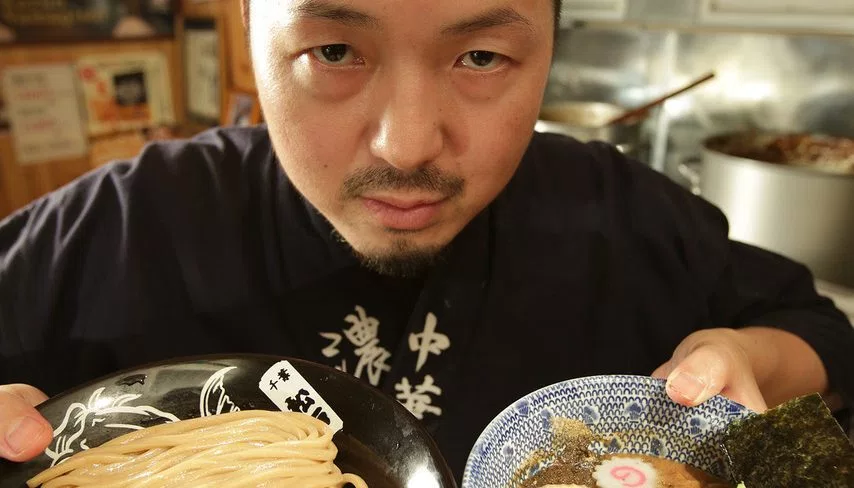ALEXIS CRUZ WRITES – There’s no doubt, movies about food are cruel to the eyes and stomach. They tease you with something you cannot smell nor taste, and sight alone doesn’t let you experience the food. “Ramen Head” is just that, featuring bowl after bowl of steamy noodles and broth that fill up every inch of the big screen, taunting the audience.
That said, this taunting is only a side effect of a foodie film done right. Director Koki Shigeno, in his first feature, focuses on obsession with ramen, both at the national and individual level. The documentary takes a journey across Japan to show the men and women who cook this quintessential dish and its impact on the Japanese.
Shigeno mainly follows chef Osama Tomita, a four-time winner of the Best Ramen Chef award. In his unassuming, ten-seat shop in Matsudo, Tomita serves $8 bowls for six hours with no breaks. He’s not shy about showing some of his secrets, taking the cameras to a room where the broth steams with vegetables and meats for a rich, dense flavor. For ramen, Tomita mixes four different broths in quantities only he knows to get a creamy look. He makes noodles from four different flours, with proportions that change with the seasons, making them long and flavorful, for maximum slurp-ability and goodness.
Obsession is the reason Tomita spends every day with ramen. On his day off, he eats at rival ramen shops and talks with chefs. His family eats ramen when they go out and Tomita enforces high standards in his apprentices. He gets frustrated when they do not show the same dedication and he hardly forgives mistakes, despite his friendly appearance. Yet, his family all seem to have gotten used to his passionate behavior.
This passion has paid off. Tomita’s fans arrive at the restaurant earlier than any of Tomita’s apprentices and wait to buy a prepaid meal. Tomita knows that a good ramen is worth eating daily and that helps him stay true to the working-class origins of ramen. It was a cheap, filling meal that has to be worth returning for to build a loyal customer base. That is something that drives Tomita: he jokes that you can’t please the ramen heads without being one yourself.
The movie largely concentrates on Tomita but it takes some detours to show other chefs and variations of ramen. There is shoyu, miso, tonkotsu and tsukemen, and there are regional variations on those categories. Chefs are free to prepare ramen their own way and evolve. The film often acts like it is for committed ramen heads and speaks to their subculture, but it doesn’t ignore ramen novices. It has an animated segment that shows the history of ramen and how the dish developed in different periods of Japanese history and describes the subtleties and flavors of different kinds of ramen.
The remarkable thing about ramen is the submissive nature it imbues in people. The film brings this up to show what obsession looks like. Almost every ramen place has patrons who are face deep into their bowls. They slurp the noodles as loudly as they can, friends hardly interact and people enter their own intimate moment with the dish. The filmmakers went to a ramen festival where they witnessed the same scene spread over parks, plazas and tents. There were crowds of people simply hunched over their bowls and eating calmly, immersed in their intimate ramen relationship.
In the final part of this fun movie, Tomita meets with two renowned ramen chefs in Japan, Shota Iida, whose ramen shop is considered the best in Kanagawa, and Yuki Onishi, the first ramen chef to get a Michelin star. The movie extols their meeting like the ultimate ramen dream team. The chefs decide to produce a meal for Tomita’s 10-year anniversary, the viewer gets to see the process of experimenting that the chefs talked about earlier in the film. The chefs share their styles to create a one of a kind meal that they serve at Tomita’s shop to a happy crowd.
The narration can be tedious at times with sparse jokes reminiscent of a typical documentary presented in high school classes. Even when describing Tomita’s process, this otherwise exceptional movie’s occasional monotone does undermine some of the excitement of seeing the ramen prepared. However, it is often poetic when it describes ramen – descriptions that along with the footage of ramen that make the movie wonderful.
{The movie is now showing in Los Angeles and New York City and will soon open in twelve states. If you see it in Los Angeles and get hungry, the Landmark NuArt theater is several blocks north of Sawtelle “Little Osaka,” where there are plenty of ramen restaurants to check out. Slurp to your heart’s content!)

